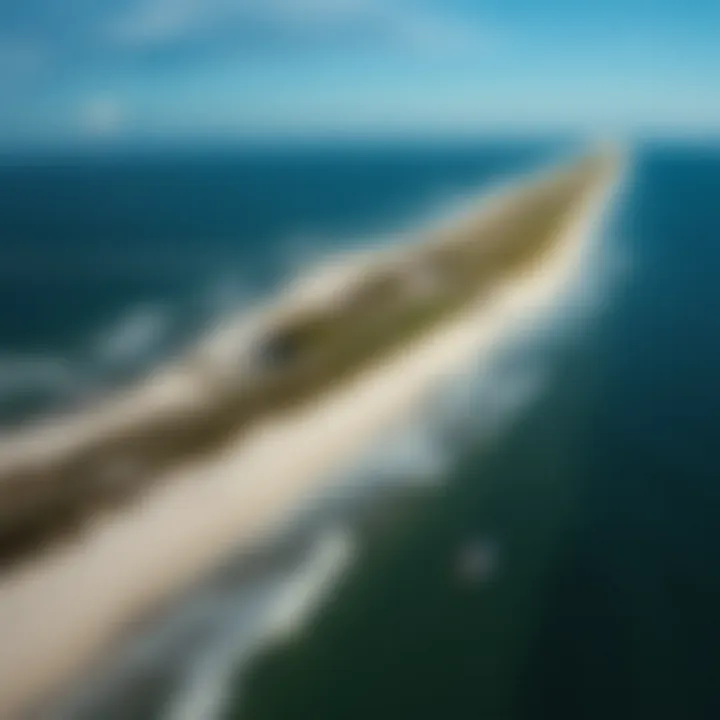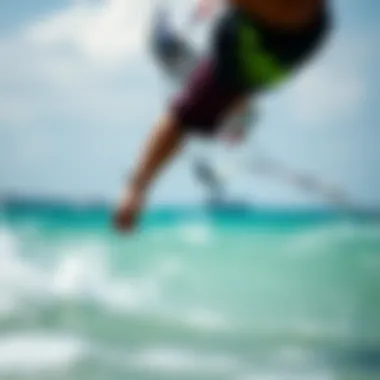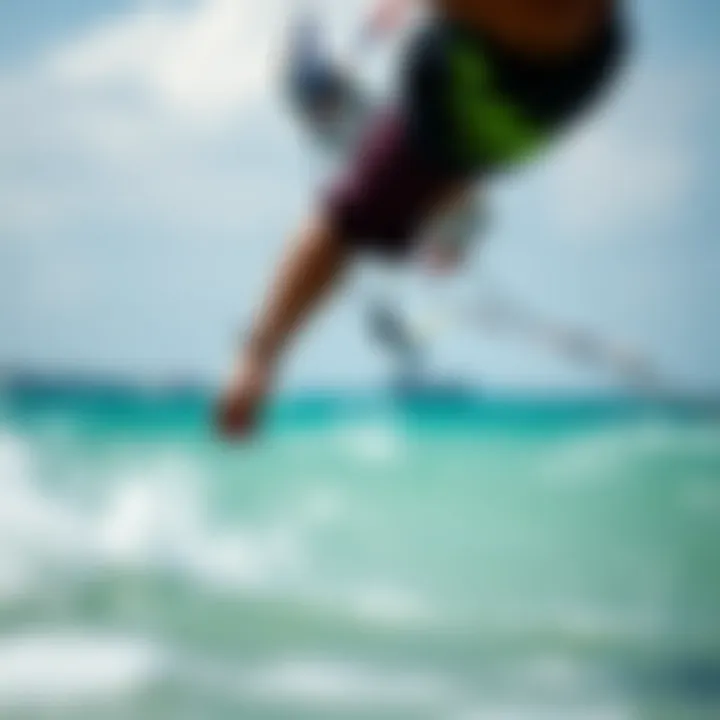Understanding New Smyrna Beach Weather: A Guide for Kiteboarders


Intro
New Smyrna Beach, a gem on the east coast of Florida, is renowned not just for its sandy shores, but also for its distinctive weather patterns that play a significant role in outdoor activities, especially kiteboarding. Understanding the local climate is paramount for both seasoned enthusiasts and newcomers looking to glimmer like a pro on the waves.
With tropical conditions that include warm temperatures and varying wind patterns, this area sees a range of climatic influences, all crucial for kiteboarding adventures. It's more than just sunshine; it involves grappling with seasonal rainfall, swells, and breezes that embody the kiteboarding experience. This guide elaborates on these intricate details, presenting a comprehensive understanding of the local weather, its seasonal swings, and the best practices to tackle those swift winds. Whether you’re considering your first kite or are on the pro circuit, knowing what to expect can make all the difference between a memorable ride and a harrowing experience.
From average temperatures to rainfall insights to wind speed nuances, we’re diving straight into what every kiteboarder needs to know to ride smoothly on New Smyrna Beach. With this guide, you’ll be armed with the knowledge to navigate the skies and surf with confidence.
Understanding the Climate of New Smyrna Beach
The climate in New Smyrna Beach is key for outdoor activities, particularly kiteboarding. Knowing the local weather patterns isn't just about comfort; it directly influences the experience a kiteboarder can expect. A seasoned rider will tell you that understanding how the climate shifts through the seasons can make or break a day on the water.
In this section, we will delve into the specific elements of New Smyrna’s climate, examining historical data and meteorological influences. This understanding helps enthusiasts avoid unexpected conditions, ensuring a safer and more enjoyable kiteboarding experience.
Geographical Overview
New Smyrna Beach, located on the east coast of Florida, has a unique geographical setup that notably influences its climate. The Atlantic Ocean lies to the east, creating a temperate climate with distinct seasonal variations. The area features sandy shores and salt marshes, which contribute to the humidity and localized weather patterns that any kiteboarder must take into account.
Some key geographical factors include:
- Proximity to the ocean: This aspect moderates temperatures, ensuring warmer winters and cooler summers compared to inland areas.
- Coastal terrain: The flat landscape allows winds to flow unobstructed, which is crucial for kiteboarding, but also means thunderstorms can develop rapidly during the warmer months.
- Natural barriers such as the Mosquito Lagoon can impact wind patterns, creating distinct riding conditions based on the area.
Understanding these geographical nuances equips kiteboarders with knowledge to predict weather better and plan their sessions accordingly.
Meteorological Factors
A variety of meteorological factors play a significant role in defining New Smyrna Beach's climate. From temperature swings to humidity levels, recognizing these elements is essential for both casual beach-goers and serious kiteboarding aficionados.
Some critical meteorological factors include:
- Temperature: Seasonal highs and lows shape the comfort level for outdoor activities. Winter generally sees milder weather, while summer might bring high temperatures and intense humidity.
- Wind patterns: Different times of the year create varying wind conditions. Kite enthusiasts know that the best winds usually come in the afternoon; understanding these daily changes can greatly influence planning.
- Precipitation: The region experiences rain, particularly during the summer months due to afternoon thunderstorms. Keeping tabs on rainfall trends helps kiteboarders avoid muddy ventures or dangerous waters.
By considering these aspects, kiteboarders can enhance their enjoyment and safety on the water. Overall, a thorough understanding of the climate acts as a foundation for making informed decisions, ensuring every session is one for the books.
"Knowledge of local weather and climate can transform an ordinary kiteboarding outing into an extraordinary adventure."
Temperature Averages Throughout the Year
Understanding temperature averages is crucial for anyone engaging with the outdoors in New Smyrna Beach. Knowing the seasonal temperatures helps kiteboarders plan their activities, ensuring that they have a safe and enjoyable experience on the water. This section dives into the fluctuating temperatures throughout the year, giving insights into the best times to catch the wind and ride the waves.
Winter Temperatures
Daily Highs
During winter, New Smyrna Beach showcases mild and pleasant temperatures. Daily highs typically hover between 65°F and 75°F (18°C to 24°C). This range makes it a favorite season for kiteboarders who prefer cooler air over the heat of summer. The pleasant daytime weather allows for extended time on the water, where one can enjoy the sun without the sweltering highs.
- Optimal kiteboarding conditions arise during the afternoons when winds pick up.
- Unique Feature: The consistency of the wind patterns during winter means that kiteboarders can expect reliable breezes.
- Advantages: Milder temperatures lead to fewer crowds on the water, allowing for a more serene experience.
However, one should be mindful of the insulated weather gear to remain cozy while kiting.
Nighttime Lows
Nighttime lows in winter can dip down to about 50°F (10°C). While it may not sound bone-chilling, nights can feel brisk, especially after an active day. Kiteboarders might find themselves packing more than just their gear for the day.
- Notable Characteristic: The temperature drop at night can create a stark contrast from the day.
- Benefits: This drop encourages evening activities, such as post-kiteboard gatherings to share experiences of the day.
- Downside: Be prepared to layer up when the sun sets. Having a light jacket or sweatshirt on-hand can enhance comfort.
Spring Transition
Rising Averages
As spring rolls in, temperatures gradually rise, usually hitting the sweet spot between 75°F and 85°F (24°C to 29°C). This warming period is essential, as it signals a transition to more active kiteboarding days. Winds become stronger, and the waters start to warm up.


- Key Characteristic: Increased daytime temperatures contribute to a vibrant atmosphere, enticing more people to engage in outdoor activities.
- Why Beneficial: For kiteboarders, these rising averages increase water sport opportunities, bringing more riders to the beach.
- Unique Feature: Local events often kick off during spring, promoting the kiteboarding culture in the area.
Humidity Levels
As temperatures rise, so does the humidity—generally averaging around 60% to 80%. For kiteboarders, understanding these humidity levels is crucial because high humidity can make the air feel warmer than it actually is.
- Key Consideration: Humidity can lead to fatigue quicker than one might expect. Staying hydrated is essential.
- Unique Aspect: High humidity can also mean a higher chance of sudden rain showers, so keeping an eye on the weather is important.
Summer Heat Challenges
Peak Temperatures
Summer often sees temperatures soaring to 90°F (32°C) and beyond. The intense heat may deter some, but for avid kiteboarders, it means prime conditions. The downside? The heat can be incredibly intense during peak hours.
- Main Advantage: The reliable thermals created by this heat are beneficial for kiteboarding.
- Consideration: Kiteboarders often have to manage their time on the water. Mid-afternoon might bring the highest temps and need to strategize their activities around cooler hours.
Heat Index
The heat index combines air temperature and humidity, making it a crucial metric during summer. It can give a reading that feels 105°F (40°C) or more! This condition makes it imperative for kiteboarders to check this index before heading out.
- Key Characteristic: Knowing the heat index can help prevent overheating and dehydration.
- Unique Feature: It emphasizes the need for proper sun protection, which is critical for summer sports enthusiasts.
Fall Cooling Trends
Temperature Drops
As fall sets in, temperatures start to drop, averaging between 70°F and 80°F (21°C to 27°C). These gentle declines make for an excellent kiteboarding climate, where sunny days often persist.
- Key Benefit: The cooler air can enhance performance by providing a refreshing contrast to previous hot months.
- Unique Feature: Kiteboarders might find ideal wind conditions with fewer gusts, leading to smoother rides.
Weather Patterns
Fall often brings unpredictable weather, with occasional tropical storms disrupting the norm. This season can surprise with its transitional behavior.
- Key Characteristic: Variation in weather patterns can lead to unexpected windy days, which might be a kiteboarder’s dream.
- Considerations: Always stay alert to updated forecasts, especially when planning a day out.
Precipitation Patterns and Impact
Understanding the patterns of precipitation in New Smyrna Beach is vital for anyone looking to fully enjoy the outdoors, especially kiteboarding enthusiasts. Knowledge of rainfall not only helps to plan kite sessions better but also allows for appreciation of local flora and fauna, which can thrive or struggle depending on the rains. By grasping the nuances of precipitation, one can navigate both skies and waters more wisely.
Monthly Rainfall Averages
Highs and Lows
Rainfall in New Smyrna Beach isn't just a matter of whether it will rain or not; it's a study in extremes. On one hand, the summer months can bring torrential downpours, really testing the limits of a kiteboarder's patience and timing. On the other hand, drier spells in winter can offer perfect conditions to be out on the water without a worry about getting soaked before the fun even begins.
This contrast of highs and lows shows just how dynamic weather can be here. Understanding when the wettest months typically fall—such as June, July, and August—allows enthusiasts to prepare ahead. Sure, the heavy rains can dampen plans, literally and figuratively, but they also rejuvenate the landscape, bringing lush vibrancy back to the area.
An interesting feature of these highs and lows is how they influence water conditions. When it pours, it can churn the waters, creating a more thrilling ride for seasoned kiteboarders. However, one must also be aware of the disadvantages—like potential flooding or hazardous debris washed into the surf.
Seasonal Variations
The seasonal variations in rainfall further enrich the climate narrative of New Smyrna Beach. Each season tells a different story: summers are typically marked by sudden storms, while winters can surprise with long stretches of dry weather. This variety ensures that no two kiteboarding experiences are the same.
The key characteristic of seasonal rainfall patterns is predictability; knowing that May showers will lead to warmer weather can change the game for someone eager to hit the waves. However, understanding these variations also has its unique features—like early spring mornings when heavy dew can create slippery grass on the beach, impacting gear setup.
While rains might be seasonal, the impact they have is year-round. More cloud cover during summer can provide needed relief from sweltering conditions, yet adverse weather phenomena can also lead to erratic winds, challenging less experienced kiteboarders.
Hurricane Season Considerations
Tracking Storms
When it comes to gauging the climate in New Smyrna Beach, there's hardly anything more significant than tracking storms, especially during hurricane season. The regularity with which hurricanes sweep through the area in late summer poses both challenges and opportunities for water sports enthusiasts.


Having the ability to track storms is a crucial skill. Familiarity with tools like the National Hurricane Center's tracking maps can keep adventurers out of harm’s way while also helping with timing their kiteboarding trips around less turbulent periods. Solid understanding leads to safer adventures, as kiteboarders can prepare for conditions before they change.
An appealing aspect of storm tracking is the excitement it can build when conditions change rapidly. Those willing to take on the risks might find themselves in some exhilarating wind conditions post-storm, though one must tread carefully to avoid debris-infested waters.
Impact on Activities
Every summer storm and hurricane brings potential shifts in the landscape and activities. The impact on activities is multi-faceted; from cancelled events to surprise good wind days after a storm lifts. Frequent fluctuations mean kiteboarders must adapt plans nearly in real-time, honing skills that extend well beyond the surf.
A key characteristic of these impacts is the way they force kiteboarders to tap into local knowledge and community resources. Engaging with people who know the waters well, such as local shops or beach patrols, can make a significant difference in how one navigates impending changes.
However, one must also remain vigilant of the disadvantages, such as increased risk of accidents or unexpected weather patterns that can turn a lovely day on the beach into a scramble for safety. Understanding the delicate balance between excitement and caution is essential yet rewarding for any sailor on the sea.
Ultimately, knowing how precipitation, seasonal changes, and hurricane considerations play out is like having a secret weapon. It allows for smart planning while maximizing enjoyment of kiteboarding adventures.
Wind Patterns and Their Influence
Understanding wind patterns can make or break your kiteboarding experience in New Smyrna Beach. Winds dictate not just the quality of your ride but also your safety on the water. This section delves into how local wind patterns play a pivotal role in kiteboarding, ensuring that enthusiasts are well-equipped for their adventures.
Prevailing Winds Overview
New Smyrna Beach is subject to a complex interplay of coastal and inland winds. The region primarily experiences easterly trade winds, which play a significant role in shaping the local climate and activities.
- Characteristics of Prevailing Winds:
These winds typically blow from the east, averaging speeds of 10 to 15 knots during most parts of the year. This easterly breeze is a godsend for kiteboarders, creating ideal conditions for powered gliding. - Seasonal Variability:
During the summer months, thermal winds can develop due to uneven heating, often bringing gusts that vary in strength throughout the day. This can lead to exhilarating conditions perfect for skilled kiteboarders looking for a challenge.
- Local Influences:
Coastal topography and bodies of water can manipulate wind patterns. As you move inland, winds can become lighter and more variable due to terrain features.
Understanding these basic wind dynamics can help kiteboarders develop a keen sense of timing their outings to align with the best wind conditions.
Best Wind Days for Kiteboarding
When it comes to kiteboarding, knowledge is power, especially when identifying the best days to hit the waves. Professionals often refer to specific forecasts and local patterns to determine optimal days for kitesurfing. Here are some key factors to consider:
- Monthly Wind Averages:
Each month in New Smyrna Beach has its characteristic wind patterns. For example, - Daytime vs. Evening Winds:
It’s worth noting that winds can behave differently based on the time of day. Many find that late afternoons offer the best winds, as thermal winds often kick in as the water remains warmer than the land. Paying attention to timing can vastly improve your sessions.
- Summer - The months of June to August can often bring consistent winds, perfect for daytime kiteboarders.
- Winter - While winds are generally lighter, cold fronts can generate stronger gusts that seasoned kiteboarders might prefer.
"Understanding wind patterns not only allows for safer kiteboarding experiences but also opens up a window of opportunities for thrilling rides."
Understanding Wind Speed Categories
Knowing how to interpret different wind speed categories is critical for anyone looking to kiteboard effectively and safely. Wind speeds are typically categorized as follows:
- Light Winds (0-10 knots):
Often too gentle for kiteboarding unless one is riding a smaller kite. It's better suited for beginners practicing their skills. - Moderate Winds (10-20 knots):
Considered ideal for most kiteboarders. This range allows for good speed and tricks without overwhelming less experienced riders. - Strong Winds (20+ knots):
This can be exhilarating for advanced riders but comes with increased risks. Understanding how your kite reacts in these conditions is vital.
Familiarizing oneself with these categories helps riders gauge their comfort level and make educated choices about when to venture out.
For more information on wind conditions, visit resources like National Weather Service or Kiteboarding Forum on Reddit.
Seasonal Weather Advisories for Kiteboarding
Understanding seasonal weather advisories for kiteboarding is essential for enthusiasts looking to maximize their experience on the waters of New Smyrna Beach. Factors such as temperature, winds, and precipitation not only influence the safety of kiteboarding but also dictate the overall enjoyment of the sport. This section delves into critical weather advisories that vary with the season, providing kiteboarders with the knowledge needed to navigate these elements efficiently.
Summer Kiteboarding Safety
Sun Exposure Precautions
During summer months, the intensity of the sun in New Smyrna Beach can be quite formidable, affecting both skin and overall health. Kiteboarders are often exposed to these relentless rays for extended periods, making sun protection paramount.
One of the key characteristics of sun exposure precautions is the use of broad-spectrum sunscreen. This option protects against both UVA and UVB rays, which is particularly relevant to those spending lengthy hours in direct sunlight. With SPF 30 or higher recommended, using sunscreen not only prevents sunburn but also diminishes the risk of skin cancer over time.
A unique feature of these precautions includes the recommendation to wear UV protective clothing. While traditional swimwear offers little protection from the sun, these specialized outfits can keep your skin safe while still allowing for a comfortable kiteboarding experience. However, despite this advantage, they may be a bit pricier than regular swimwear, which can be a consideration for some.
"Preventing sunburn not only enhances your water sports experience, but also safeguards your skin health for years to come."


Water Conditions
The summer period in New Smyrna Beach usually presents warm waters spiked with occasional turbulence. These water conditions can greatly contribute to the overall kiteboarding experience. The warm waters, typically reaching upwards of 80°F (27°C), encourage comfort for thrill-seekers, allowing you to extend your time in the waves.
One notable characteristic of water conditions during the summer season is the occurrence of occasional afternoon showers or thunderstorms, which can impact the safety and viability of kiteboarding. While these storms often disperse quickly, they can introduce unforeseen changes in wind patterns and water currents, compelling kiteboarders to remain ever-vigilant.
A distinctive feature to keep in mind is the phenomenon known as "storm surge," where tides can rise considerably due to nearby storms. This can either enhance or hinder local kiteboarding conditions depending on the timing and severity. Both novice and seasoned riders must evaluate real-time weather updates to navigate these waters safely.
Winter Preparation Tips
Appropriate Gear
During winter months, the vibe shifts, and kiteboarders in New Smyrna Beach face different weather conditions. Choosing the right gear becomes pivotal for ensuring safety and comfort. A prominent characteristic is investing in thermal wetsuits, which provide insulation against the cooler water temperatures while still allowing for movement.
The unique feature of layering is also vital during this season. Donning a base layer under the wetsuit can be quite beneficial, retaining heat without sacrificing flexibility. While it may require a bit more planning, the right gear can significantly enhance the kiteboarding experience in cooler months. However, the need for added gear and gear maintenance can hit the wallet a little harder, making it a less favorable choice for those on a budget.
Cold Weather Effects
Winter brings several cold weather effects that can impact kiteboarding. Cooler air temperatures paired with wind can lead to chills that may not just deter enjoyment but could potentially lead to hypothermia if precautions aren’t taken.
A noteworthy characteristic of these cold weather effects is reduced visibility. Shorter daylight hours mean kiteboarders must be cautious about timing their sessions to avoid sailing home in the dark. Additionally, light drizzle or mist can diminish visibility further, making it increasingly difficult to assess conditions.
Being aware of these effects allows kiteboarders to make informed choices about when to hit the water and how to prepare accordingly. Knowing how to manage the risks associated with these colder times will be vital for a safe and enjoyable kiteboarding season.
Local Climate Changes and Trends
The climate in New Smyrna Beach is more than just a backdrop for beachgoers and kiteboarding enthusiasts; it’s a dynamic system that influences local ecosystems, recreational opportunities, and even economic activities. Understanding the local climate changes and trends is crucial for anyone looking to enjoy the area's unique weather conditions while staying safe and prepared.
Long-term Weather Trends
Long-term weather trends in New Smyrna Beach indicate a shift, pointing towards warmer temperatures and changing precipitation patterns. Over the past few decades, historical weather data shows a consistent rise in average temperatures, particularly noticeable during the summer months. This development not only affects kiteboarding conditions—the winds can shift as the temperatures rise—but also influences marine life and coastal integrity.
To grasp these trends, kiteboarding enthusiasts can analyze yearly averages for temperature and precipitation:
- Average summer temperatures have increased by roughly 2°F, leading to more balmy days.
- Rainfall patterns display variability, with some years experiencing unusually heavy downpours, while others seem dryer than the historical norm.
These fluctuations imply significant variations in kiteboarding conditions, impacting both safety and enjoyment on the water.
Impact of Climate Change
As we delve into the specifics, the implications of climate change on New Smyrna Beach are impossible to ignore. Rising sea levels threaten beach erosion, which can directly impact kiteboarding locations and infrastructure like ramp access and launch areas. The greater frequency of storms, attributed to climate change, can also alter local wind patterns, which are vital for safe kiteboarding.
This aspect warrants attention:
"Changes in climate are not just statistics; they shape the very experience of outdoor activities such as kiteboarding."
Moreover, shifting weather tides could mean more intense storms during previously calm months, presenting new challenges for those wanting to hit the water. Local professionals and enthusiasts must stay informed. Monitoring updates from meteorological organizations, such as NOAA, ensures that kiteboarders are well-prepared for these changing conditions.
In summary, understanding local climate changes and trends equips kiteboarders and outdoor enthusiasts with crucial knowledge necessary to navigate the specific weather conditions they may encounter, allowing them to enjoy their activities with a keen awareness of environmental impacts.
Culmination and Future Insights
Drawing to a close, this exploration of New Smyrna Beach’s climate highlights the significant role that weather conditions play in shaping this vibrant coastal community. Understanding the local climate isn’t just crucial for kiteboarding enthusiasts—it’s vital for anyone looking to experience the region to its fullest.
Consolidating the information presented, readers can clearly see how temperature fluctuations, rainfall patterns, and wind events impact not only outdoor activities but also daily life. As the area grapples with broader climate trends, like rising temperatures and seasonal shifts, awareness is key for residents and visitors alike. By staying informed, everyone can make smarter decisions about when to engage in recreational activities or plan travel.
Summary of Key Points
- New Smyrna Beach enjoys a subtropical climate that features warm summers and mild winters.
- Seasonal temperature variations are significant, with summer heat hitting peaks that can affect outdoor plans.
- Rainfall trends reveal a pronounced wet season, particularly during hurricane time, during which preparations are necessary.
- Wind conditions provide the perfect opportunity for kiteboarding but also require attention to safety and preparedness.
The interplay of these elements creates an environment that's both challenging and rewarding for those who love the outdoors.
Implications for Kiteboarding
For kiteboarding enthusiasts, the implications of New Smyrna Beach’s climate are multifaceted. The area’s wind patterns fluctuate throughout the year, making it essential for riders to be knowledgeable of when conditions are ideal for high-flying stunts or leisurely gliding.
- Safety first: A solid understanding of prevailing winds can help kiteboarders avoid unexpected changes in conditions that could compromise safety.
- Maximize enjoyment: By choosing the right times for kiteboarding, enthusiasts can ensure they take advantage of the strong winds and pleasant weather that New Smyrna Beach is famous for.
- Community insights: Engaging with local kiteboarding groups or forums can yield invaluable information about real-time conditions, local tips, and shared experiences.
The evolving climate demands that kiteboarding aficionados remain not only skilled in their craft but also adaptive and responsive to the changing atmosphere. With the right knowledge and preparation, one can harness the exhilarating wind and waves of New Smyrna Beach, ensuring each session on the water is not only enjoyable but also safe.















